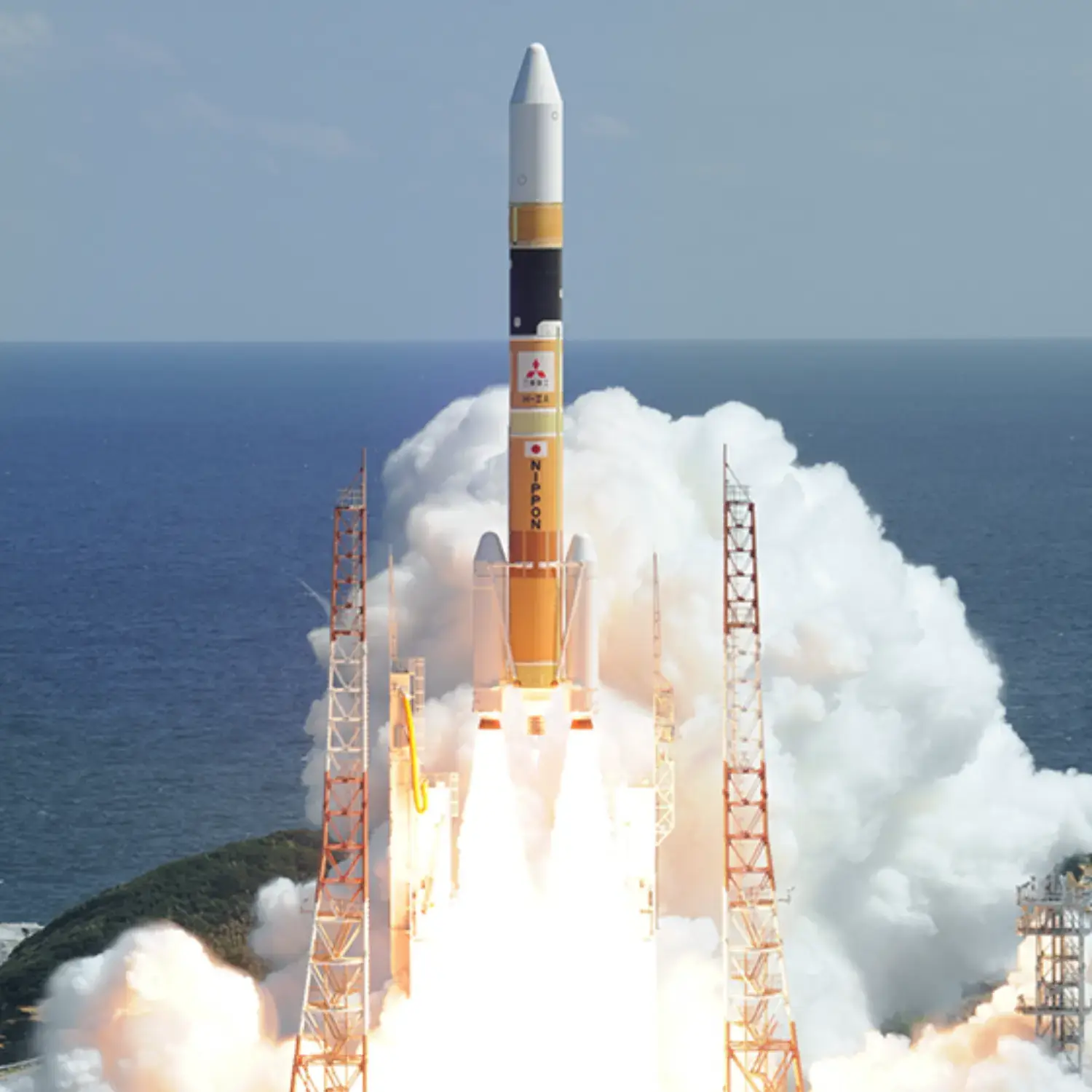/
Hayabusa 2 & Others
Launch Success
Liftoff Time (GMT)
04:22:00
Wednesday December 3, 2014
Watch Replay
Official Livestream
Mission Details
Read Article
Shin'en 2
Shin'en 2 is a interplanetary satellite built by students at Kyushu Institute of Technology and Kagoshima University, AUT in Japan that carries a 145 to 435 MHz linear transponder into a deep space heliocentric orbit. The 15 kg spacecraft, measuring 490 × 490 × 475 mm, features a lightwight thermoplastic CFRP structure. It is powered by solar cells on the polyheadral surface of the satellite body. Shin'en 2 will orbit the Sun in an elliptic orbit between Venus and Mars. Its inclination will be almost zero, which means Shin'en 2 will stay in the Earth’s equatorial plane. The distance from the Sun will be between 0.7 and 1.3 AU. The goals of the mission are: To establish communication technologies with a long range as far as moon. To establish a new technology of the ultra-light-weight satellite. Proposing a WSJT 29 dBm UHF downlink and a 29 dBm 20 kHz linear transponder and a CW beacon all on UHF with a VHF uplink for the transponder Shin'en 2 is planned to launch in the 4th quarter of 2014 on an H-2A-202 rocket with Hayabusa 2 as the main payload and PROCYON and ARTSAT2:DESPATCH as secondary payloads. After launch, Shin'en 2 got the additional designation Fuji OSCAR 82 (FO 82).
Selenocentric
1 Payload
15 kilograms
PROCYON
PROCYON (Proximate Object Close flyby with Optical Navigation) is an experimental asteroid fly-by probe developed by JAXA. The probe with a mass of only 59 kg was to perform an close fly-by to an asteroid by using optical navigation. Two more asteroid fly-bys were planned. PROCYON was launched in mid 2014 on a H-2A-202 rocket with the asteroid explorer Hayabusa 2 as the main payload. The target asteroid for PROCYON is 2000 DP107, which has small moon. PROCYON's ion engine has operated for more than 223 hours in total. Thrust is 366 µN, more than the specification of 300 µN. The ion engine's high voltage power trouble is the most problematic situation, which might be caused by small metal debris. If the problem is not resolved end of April 2015, the planned Earth fly-by on 3 December 2015 and the asteroid fly-by observation on 12 May 2016 will be difficult. In early May 2015, the plans to visit asteroid (185851) 2000 DP107 were abandoned after recovery of ion thrusters failed.
Heliocentric Orbit
1 Payload
59 kilograms
Hayabusa 2
Hayabusa-2 is a follow-on mission to the similar MUSES-C (Hayabusa) mission that will return samples of surface from an asteroid to the earth. Target asteroid, however, is different. Asteroid Itokawa explored by Hayabusa is rock-rich S-type one. Asteroid that Hayabusa-2 will visit at is a C-type asteroid. C-type asteroids are also rocky, but it is thought that their rocks contain much more organic matters. The asteroid selected as a target of Hayabusa-2 is Asteroid (162173) Ryugu (1999 JU3). Observation of spectrum of sunlight reflected by the asteroid shows that it has features of C-type. Hayabusa-2 will fly to the target asteroid by using ion engines as with Hayabusa. The spacecraft is almost the same as Hayabusa, but problematic points discovered during the Hayabusa mission will be corrected. The antenna type will be also different. Hayabusa-2 will use a dual planar antenna (X- and Ku-band) in place of the parabolic one of Hayabusa. A new device carried by the mission is SCI (Small Carry-on Impactor), a small drop-off Explosively formed penetrator. The shaped charge will consist of 4.5 kg of plasticized HMX and a 2.5 kg copper liner. The explosion will form a copper penetrator hitting the asteroid with a velocity of 2 km/s. The crater formed by the impact will allow further observations by the onboard instruments. SCI will be deployed bay Hayabusa-2 near the surface. The low gravity allows Hayabusa-2 enough time to maneuver on to the opposite side of the asteroid to be protected by the explosion and the impact. To observe the explosion and the impact, the DCAM-3 deployable camera subsatellite is also deployed. It is similar to the DCAM subsatellites deployed by IKAROS. Hayabusa 2 carries also the small 10 kg MASCOT (Mobile Asteroid Surface Scout) lander developed by the German DLR and the French CNES and three MINERVA-2 (Micro/Nano Experimental Robot Vehicle for Asteroid) hopping landers ("rovers") - MINERVA-2-1A, MINERVA-2-1B and MINERVA-2-2.
Low Earth Orbit
1 Payload
609 kilograms
DESPATCH
The DESPATCH (Deep Space Amateur Troubadour’s Challenge) space probe was an art project of the Tama Art University. It is the second mission of the "ARTSAT: Art and Satellite Project". The sculpture, which is 50 by 50 by 45 cm with a mass of 32 kg, was developed at the Tama Art University using a 3D Printer. The containment vessel carried a CW beacon in the 435 MHz band using an omni-directional antenna. The satellite should provide the ultimate in ham radio DX reception when at its maximum operational distance of 3 million km from Earth about a week after launch. Being battery powered without solar panels it had a low transmit cycle to maximize the lifespan. The ARTSAT2 Deep Space sculpture “DESPATCH” was launched 2 December 2014 on a H-2A-202 rocket with the asteroid explorer Hayabusa 2 as the main payload and two more secondary payloads. After launch, DESPATCH got the additional designation Fuji OSCAR 81 (FO 81). DESPATCH operated successfully. On 7 December 2014, the signal was received from a distance of more than 2.000.000 km. The last signal was received in January 2015 from a distance of about 4.700.000 km.
Selenocentric
1 Payload
32 kilograms
Launch Site
Stats
H-IIA
26th
Mission
4th
Mission of 2014
2014
78th
Orbital launch attempt

